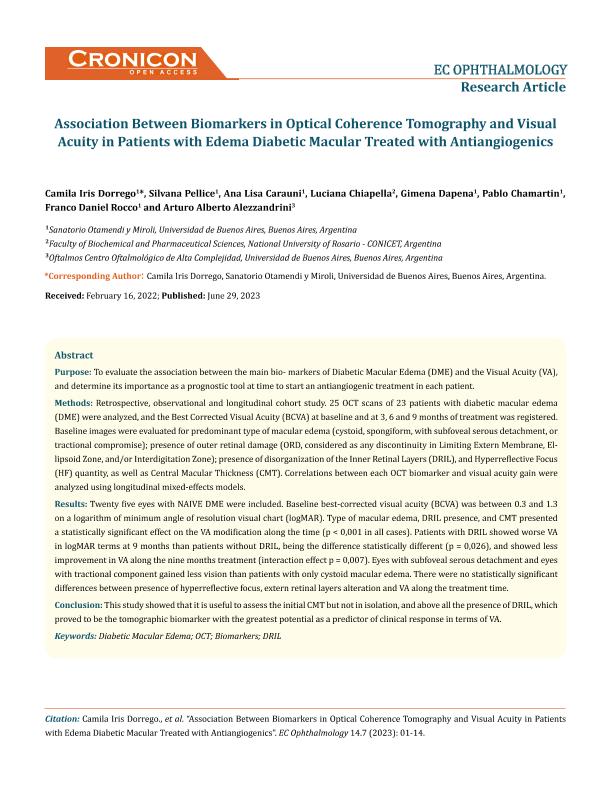Artículo
Association Between Biomarkers in Optical Coherence Tomography and Visual Acuity in Patients with Edema Diabetic Macular Treated with Antiangiogenics
Dorrego, Camila Iris; Pellice, Silvana; Carauni, Ana Lisa; Chiapella, Luciana Carla ; Dapena, Gimena; Chamartin, Pablo; Rocco, Franco Daniel; Alezzandrini, Arturo Alberto
; Dapena, Gimena; Chamartin, Pablo; Rocco, Franco Daniel; Alezzandrini, Arturo Alberto
 ; Dapena, Gimena; Chamartin, Pablo; Rocco, Franco Daniel; Alezzandrini, Arturo Alberto
; Dapena, Gimena; Chamartin, Pablo; Rocco, Franco Daniel; Alezzandrini, Arturo Alberto
Fecha de publicación:
06/2023
Editorial:
ECronicon
Revista:
EC Ophtalmology
ISSN:
2453-188X
Idioma:
Inglés
Tipo de recurso:
Artículo publicado
Clasificación temática:
Resumen
Purpose: To evaluate the association between the main bio- markers of Diabetic Macular Edema (DME) and the Visual Acuity (VA), and determine its importance as a prognostic tool at time to start an antiangiogenic treatment in each patient. Methods: Retrospective, observational and longitudinal cohort study. 25 OCT scans of 23 patients with diabetic macular edema (DME) were analyzed, and the Best Corrected Visual Acuity (BCVA) at baseline and at 3, 6 and 9 months of treatment was registered. Baseline images were evaluated for predominant type of macular edema (cystoid, spongiform, with subfoveal serous detachment, or tractional compromise); presence of outer retinal damage (ORD, considered as any discontinuity in Limiting Extern Membrane, Ellipsoid Zone, and/or Interdigitation Zone); presence of disorganization of the Inner Retinal Layers (DRIL), and Hyperreflective Focus (HF) quantity, as well as Central Macular Thickness (CMT). Correlations between each OCT biomarker and visual acuity gain were analyzed using longitudinal mixed-effects models. Results: Twenty five eyes with NAIVE DME were included. Baseline best-corrected visual acuity (BCVA) was between 0.3 and 1.3 on a logarithm of minimum angle of resolution visual chart (logMAR). Type of macular edema, DRIL presence, and CMT presented a statistically significant effect on the VA modification along the time (p < 0,001 in all cases). Patients with DRIL showed worse VA in logMAR terms at 9 months than patients without DRIL, being the difference statistically different (p = 0,026), and showed less improvement in VA along the nine months treatment (interaction effect p = 0,007). Eyes with subfoveal serous detachment and eyes with tractional component gained less vision than patients with only cystoid macular edema. There were no statistically significant differences between presence of hyperreflective focus, extern retinal layers alteration and VA along the treatment time. Conclusion: This study showed that it is useful to assess the initial CMT but not in isolation, and above all the presence of DRIL, which proved to be the tomographic biomarker with the greatest potential as a predictor of clinical response in terms of VA.
Palabras clave:
Diabetic Macular Edema
,
OCT
,
Biomarkers
,
DRIL
Archivos asociados
Licencia
Identificadores
Colecciones
Articulos(CCT - ROSARIO)
Articulos de CTRO.CIENTIFICO TECNOL.CONICET - ROSARIO
Articulos de CTRO.CIENTIFICO TECNOL.CONICET - ROSARIO
Citación
Dorrego, Camila Iris; Pellice, Silvana; Carauni, Ana Lisa; Chiapella, Luciana Carla; Dapena, Gimena; et al.; Association Between Biomarkers in Optical Coherence Tomography and Visual Acuity in Patients with Edema Diabetic Macular Treated with Antiangiogenics; ECronicon; EC Ophtalmology; 14; 7; 6-2023; 1-14
Compartir



